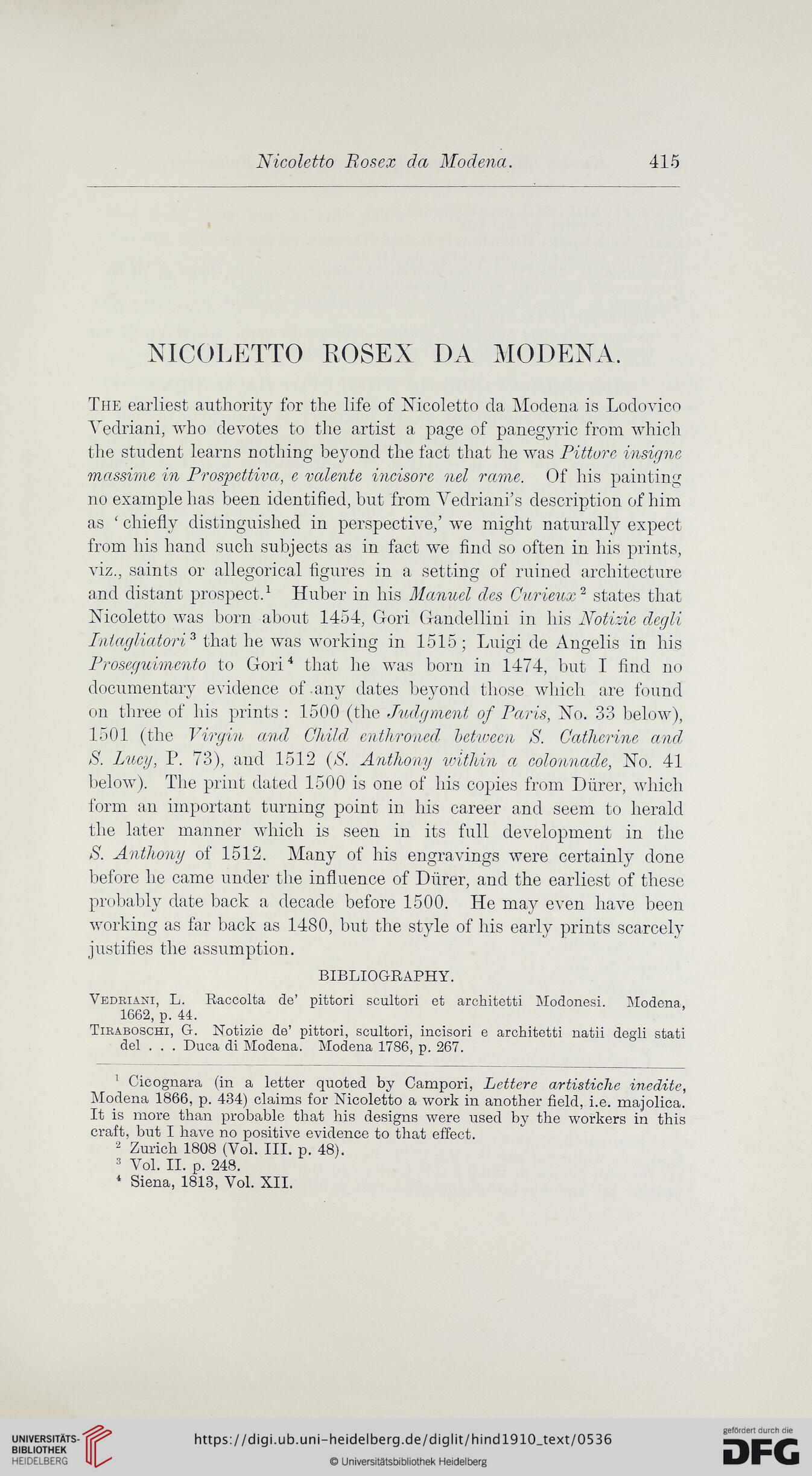Nicoletto Rosex da Modena.
415
NICOLETTO ROSEX DA MODENA.
The earliest authority for the life of Nicoletto da Modena is Lodovico
Vedriani, who devotes to the artist a page of panegyric from which
the student learns nothing beyond the fact that he was Pittore insigne
massime in Prospettiva, e valente incisore nel rame. Of his painting
no example has been identified, but from Vedriani’s description of him
as ‘ chiefly distinguished in perspective,’ we might naturally expect
from his hand such subjects as in fact we find so often in his prints,
viz., saints or allegorical figures in a setting of ruined architecture
and distant prospect.1 Huber in his Manuel des Curieux2 3 states that
Nicoletto was born about 1454, Gori Gandellini in his Notizie degli
IntagliatoriP that he was working in 1515; Luigi de Angelis in his
Proseguimento to Gori4 that he was born in 1474, but I find no
documentary evidence of .any dates beyond those which are found
on three of his prints : 1500 (the Judgment of Paris, No. 33 below),
1501 (the Virgin and Child enthroned- between >S'. Catherine- and
S. Lucy, P. 73), and 1512 (S. Anthony within a colonnade, No. 41
below). The print dated 1500 is one of his copies from Diirer, which
form an important turning point in his career and seem to herald
the later manner which is seen in its full development in the
S. Anthony of 1512. Many of his engravings were certainly done
before he came under the influence of Diirer, and the earliest of these
probably date back a decade before 1500. He may even have been
working as far back as 1480, but the style of his early prints scarcely
justifies the assumption.
BIBLIOGRAPHY.
Vedriani, L. Raccolta de’ pittori scultori et architetti Modonesi. Modena,
1662, p. 44.
Tiraboschi, G. Notizie de’ pittori, scultori, incisori e architetti natii degli stati
del . . . Duca di Modena. Modena 1786, p. 267.
1 Cicognara (in a letter quoted by Campori, Lettere artistiche inedite,
Modena 1866, p. 434) claims for Nicoletto a work in another field, i.e. majolica.
It is more than probable that his designs were used by the workers in this
craft, but I have no positive evidence to that effect.
2 Zurich 1808 (Vol. III. p. 48).
3 Vol. II. p. 248.
4 Siena, 1813, Vol. XII.
415
NICOLETTO ROSEX DA MODENA.
The earliest authority for the life of Nicoletto da Modena is Lodovico
Vedriani, who devotes to the artist a page of panegyric from which
the student learns nothing beyond the fact that he was Pittore insigne
massime in Prospettiva, e valente incisore nel rame. Of his painting
no example has been identified, but from Vedriani’s description of him
as ‘ chiefly distinguished in perspective,’ we might naturally expect
from his hand such subjects as in fact we find so often in his prints,
viz., saints or allegorical figures in a setting of ruined architecture
and distant prospect.1 Huber in his Manuel des Curieux2 3 states that
Nicoletto was born about 1454, Gori Gandellini in his Notizie degli
IntagliatoriP that he was working in 1515; Luigi de Angelis in his
Proseguimento to Gori4 that he was born in 1474, but I find no
documentary evidence of .any dates beyond those which are found
on three of his prints : 1500 (the Judgment of Paris, No. 33 below),
1501 (the Virgin and Child enthroned- between >S'. Catherine- and
S. Lucy, P. 73), and 1512 (S. Anthony within a colonnade, No. 41
below). The print dated 1500 is one of his copies from Diirer, which
form an important turning point in his career and seem to herald
the later manner which is seen in its full development in the
S. Anthony of 1512. Many of his engravings were certainly done
before he came under the influence of Diirer, and the earliest of these
probably date back a decade before 1500. He may even have been
working as far back as 1480, but the style of his early prints scarcely
justifies the assumption.
BIBLIOGRAPHY.
Vedriani, L. Raccolta de’ pittori scultori et architetti Modonesi. Modena,
1662, p. 44.
Tiraboschi, G. Notizie de’ pittori, scultori, incisori e architetti natii degli stati
del . . . Duca di Modena. Modena 1786, p. 267.
1 Cicognara (in a letter quoted by Campori, Lettere artistiche inedite,
Modena 1866, p. 434) claims for Nicoletto a work in another field, i.e. majolica.
It is more than probable that his designs were used by the workers in this
craft, but I have no positive evidence to that effect.
2 Zurich 1808 (Vol. III. p. 48).
3 Vol. II. p. 248.
4 Siena, 1813, Vol. XII.




